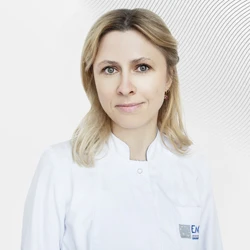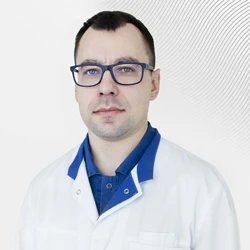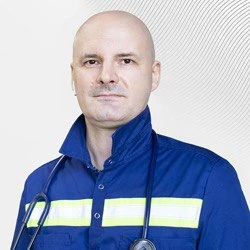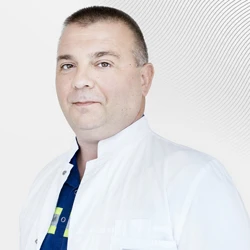Renal colic
Author: Urologist, MD, Professor, Head of the Urological Clinic, Head of the Department of Urology at the EMC Medical School Grigoriev Nikolay
Renal colic is a kind of exacerbation of urolithiasis. It occurs due to a sharp violation of the outflow of urine from the kidney due to the migration of stones. Kidney stones that do not disrupt the outflow of urine usually do not cause pain. They originate and grow, often reaching very large sizes. The pain appears when the stone leaves its place and begins to move with the flow of urine. At the same time, small stones (4-6 mm) can cause more concern than large ones. A small stone easily penetrates the ureter, the walls of which react to a foreign object with a persistent spasm, which leads to a sharp violation of the outflow of urine. Renal colic begins. This is a very serious and dangerous condition. If you do not seek urgent help, complications may occur, including kidney death.
Emergency renal colic service is available at the EMC around the clock. Specialists will help to quickly relieve pain and eliminate the risk of possible complications.
Symptoms of renal colic
- Sharp pain in the side, in the lower back, which can radiate to the abdomen, groin, genitals. The pain is very severe, cramping, sharp, cutting in nature.
- Nausea and vomiting.
- Urinary retention.
- An admixture of blood in the urine.
- Increased blood pressure.
- The pain does not subside when the body position changes.
Renal colic in children
The younger the child, the less pronounced the local symptoms and the more pronounced the general ones. Renal colic in young children is manifested by severe motor restlessness, the child is tossing in bed, kicking his legs, complaining of pain all over his stomach without precise localization. The abdomen is sharply swollen, tense, there is frequent vomiting, urinary retention, and fever.
Older children have more characteristic symptoms. The child complains of pain in the lumbar region, which has a characteristic orientation along the ureter to the iliac region, to the genitals and along the thigh. With a low location of the stone, colic is often accompanied by frequent painful urination with pain radiating to the glans penis and labia majora. Vomiting and flatulence also usually accompany an attack.
Renal colic often occurs against the background of a child's full health, however, with urolithiasis, previous physical activity, walking, running may be a provoking factor. An attack of renal colic can last from several hours to several days, the cessation of pain does not indicate recovery, and in the absence of adequate diagnosis and treatment, it usually resumes after a while. Frequent seizures negatively affect kidney function and require immediate treatment.
In young children, renal colic symptoms resemble intestinal obstruction, so it is very important to make a differential diagnosis.
Renal colic in pregnant women
During pregnancy, the load on the body increases by 2 or even more times. The immune system weakens, metabolic processes change, and chronic diseases can worsen. One of the diseases that often progress during pregnancy is urolithiasis.
In addition to severe pain due to a violation of the outflow of urine from the kidney, high risks to the health and life of the baby are added. Blood supply disorders, oxygen starvation of the fetus, premature birth are a number of complications of urolithiasis during pregnancy.
The diagnostic capabilities of doctors in this case are severely limited, since X-rays that are dangerous to the fetus are not performed. Usually, a stent is placed between the kidney and the bladder for the entire duration of pregnancy. The stent allows for the outflow of urine from the kidney bypassing the stone. It is possible to carry out a full diagnosis and treatment only after childbirth.
This method has significant disadvantages. First, the inconvenience. The presence of a stent leads to severe discomfort and pain. Secondly, stents need to be replaced after a certain period of time, because they can fail. These manipulations can affect the condition of the fetus.
Treatment of urolithiasis in EMC
The urologists of the EMC clinic use a safe and effective method of removing stones – flexible endoscopy. Qualifications and extensive work experience, including in leading foreign clinics, allow EMC doctors to perform this operation without X-rays. Another advantage is that the manipulation is performed without punctures and incisions, which ensures minimal recovery time and excellent aesthetic effect. The main advantage of this technique is that the risks for the unborn baby are significantly reduced.
Causes of renal colic
Renal colic is not an independent disease. This is a complication of a number of diseases.:
- urolithiasis,
- inflammation and injury of the kidneys,
- tuberculosis of the kidney,
- congenital anomalies,
- benign or malignant neoplasms,
- allergic reactions accompanied by swelling of the ureters,
- Ormond's disease.
Stones are formed due to a violation of salt metabolism. First, the crystallization core appears as a cluster of stable microscopic crystals. Over time, more and more salts are fixed on the core, which form a stone. Stones grow asymptomatically and make themselves felt only when the stone closes the lumen of the urinary tract. The stone clogs the lumen of the ureter and renal pelvis, disrupting the outflow of urine and injuring the walls of organs, which causes colic.
In the case of pyelonephritis, peeling of the renal epithelium occurs, suppuration and deposition of fibrin, which can cause blockage of the ureteral lumen. As a result, renal colic develops.
Injury to the kidney tissue can lead to bleeding and the formation of clusters of blood clots, as well as scar tissue blocking the lumen of the urinary tract.
With tuberculosis of the kidney, specific tuberculous granuloma formations, pus-like masses are formed, and the epithelium of the renal tissue is exfoliated. These factors together can lead to difficulty in the outflow of urine.
Tumor formations can grow into the cavity of the organs of the urinary system or squeeze them from the outside, increasing, the formations close the lumen of the ureter, which causes renal colic.
When to seek medical help for renal colic
If you feel unbearable pain in the lumbar region accompanied by one of the above symptoms, you need to urgently call an ambulance team at home or ask your family or friends to take you to the emergency department. Loss of time can lead to complications, including kidney loss, chronic kidney failure, and even death of the patient.
Self-medication is contraindicated in this case. Also, if renal colic occurs for the first time, it is not recommended to take any medications before the arrival of an ambulance team or a doctor's examination, this may complicate the diagnosis.
Which doctor should I go to for renal colic
If you arrive at the emergency department, the doctor on duty will examine you, prescribe the necessary diagnostic tests and, if necessary, invite the urologist on duty to carry out measures to restore the outflow of urine from the kidney. If you call an ambulance, the doctor will conduct an examination at home, make a preliminary diagnosis and transport you to the clinic for its clarification and treatment.
Diagnosis of diseases that caused renal colic
According to research, only one quarter of the total number of patients admitted with suspected renal colic are diagnosed with this pathology. Therefore, the doctor's task is not only to quickly and correctly diagnose the patient's condition, but also to identify the cause of renal colic. Because in addition to relieving pain and removing the stone, the patient may need treatment for the underlying disease that caused renal colic. The EMC has all the facilities for this: its own clinical and diagnostic laboratories, modern diagnostic equipment of expert class, operating rooms equipped with the latest technology, and a 24-hour hospital.
Diseases that can be confused with renal colic
Acute appendicitis. Due to the proximity of the appendix to the right ureter, this is the most common diagnostic error. According to statistics, 40% of patients with renal colic have appendicitis removed. The main difference between appendicitis is the time of vomiting (with colic, vomiting occurs immediately, with appendicitis a long time after the onset of the disease) and the patient's motor activity (with appendicitis, patients lie relatively calmly, with renal colic they constantly move, trying to take a position that relieves pain).
Hepatic colic. The percentage of diagnostic errors in this case is much lower. Hepatic colic is also characterized by sharp and severe pain localized in one place. However, in the case of renal colic, the pain thaws down into the abdomen and genitals, while in the case of hepatic colic, it spreads upward into the chest, shoulder blade and right shoulder. In addition, there is a clear link between hepatic colic and a violation of the diet, whereas the diet does not affect renal colic in any way.
Acute pancreatitis. In general, the symptoms are similar, the main difference is that with pancreatitis, blood pressure drops, while with renal colic it does not change or increases slightly.
Intestinal obstruction. Symptoms similar to renal colic include bloating and flatulence. The main difference is the nature of the pain. With renal colic, it is constant, and with intestinal obstruction, it is cramping, depending on the frequency of contraction of the intestinal muscles. Another difference is that with intestinal obstruction due to peritonitis, a high fever rises. With renal colic, the temperature does not exceed 38.
Abdominal aortic aneurysm. Like renal colic, an aneurysm can be accompanied by abdominal pain radiating to the lumbar region, bloating, nausea and vomiting. The main difference is the very low pressure during aneurysm.
Lumbosacral sciatica. Severe, sharp lower back pain is also present, but unlike colic, there is no nausea, vomiting, or urinary retention. The intensity of sciatica pain varies with body position.
Inflammation of the appendages. Often, with this disease, pain radiates to the lower back, but the woman feels pain in the sacrum and uterus, which is easily diagnosed by palpation.
Tests and examinations for renal colic
Diagnosis of renal colic is not difficult and is carried out in the EMC as soon as possible. It usually takes about an hour from the moment the patient is admitted to the clinic to the final diagnosis and decision on surgical treatment.
Diagnostic steps include:
An assessment of the general condition and vital functions is carried out: consciousness, respiration, blood circulation (pulse, heart rate and respiration, blood pressure), the presence of motor anxiety. Then palpation of the abdomen in order to exclude acute surgical pathology. During the procedure, the doctor notes the presence of postoperative scars.
Then the doctor checks for the main symptoms of renal colic:
- Consultation and examination by an on-duty doctor of the emergency department and a urologist.
- a symptom of shaking (the patient reports painful sensations during the tapping procedure) in the area of pain localization;
- using palpation of the lumbar region, the doctor determines whether soreness has appeared on the side of the lesion;
- the presence of associated symptoms: dysuria, nausea, vomiting, gas retention, stool, fever.
Emergency general urinalysis, rapid diagnosis of microhematuria (high red blood cell count), blood tests (general, biochemical). Normal urine test results do not exclude renal colic, they indicate the absence of urine outflow from a blocked kidney.
Ultrasound of the urinary system is an ideal initial examination of patients with renal colic. Non-invasive, fast, portable. Ultrasound reveals stones in the calyx-pelvic system, in the pelvic-ureteral segment and the intramural part of the ureter. Transrectal and trasvaginal ultrasounds can detect stones in the ureteral appendectomy.
- CT scan of the urinary system. The progression of renal colic is fraught with dangerous complications and causes suffering to the patient. CT is performed to identify the cause of the stone and is performed without contrast. This method is also used in controversial situations, when the cause of some symptoms is unclear, and before surgery to clarify the location of the stone.
Urolithiasis as one of the most common causes of renal colic
Urolithiasis is a common disease that affects from 5 to 15% of the population. About half of the total number of patients are susceptible to the re-formation of stones, therefore, proper prevention and compliance with recommendations are of great importance. More than 70% of renal colic is diagnosed at the age of 20-50 years, men are twice as likely as women.
There are a number of prerequisites for the formation of stones:
- Insufficient urine volume. If the body produces no more than 1 liter of urine per day, it becomes more concentrated, it can stagnate, which leads to its oversaturation with dissolved substances and, as a result, the formation of stones.
- Hypercalciuria. This condition may be a consequence of increased blood calcium levels, hypervitaminosis D, hyperparathyroidism, and eating high-protein foods. Hypercalciuria increases the concentration of calcium salts in the urine, which leads to the formation of crystals. About 80% of kidney stones contain calcium.
- High levels of uric acid, oxalates, sodium urate, or cystine in the urine. This urine composition is a consequence of a diet high in protein, salts, and oxalates, as well as a possible genetic disorder that causes increased excretion.
- An infection caused by urea-digesting bacteria. They destroy urea, increasing the concentration of ammonia and phosphorus, which promotes the formation and growth of stones.
- Insufficient levels of citric acid salts in the urine. Their role is to lower the acidity of urine and slow down the growth and formation of crystals. The optimal level of citric acid salts in urine is 250 mg/l to 300 mg/l.
- Obesity, hypertension, diabetes mellitus. All these diseases contribute to the formation of kidney stones and the appearance of renal colic.
Complications of renal colic
Renal colic is a signal that a dangerous pathological process is taking place in the body that requires treatment.
The most common complications are:
- Painful shock. It occurs with sharp and severe pain, as a result, the nervous, respiratory and cardiovascular systems suffer. The condition can be life-threatening.
- Pyelonephritis is an inflammation of the pelvis and parenchyma of the kidney.
- Urosepsis is a complication resulting from an infectious and inflammatory process in the genitourinary organs. A life-threatening condition.
- Prolonged urinary retention is the inability to completely empty the bladder due to a violation of the outflow of urine.
- Pionephrosis is a purulent destructive process inside the kidney.
- Nephrosclerosis is the replacement of the renal parenchyma by connective tissue, which disrupts kidney function and leads to complete organ atrophy.
- Hydronephrosis is an enlargement of the renal pelvis due to a deterioration in the outflow of urine, which leads to a decrease in the viability of the organ.
- Narrowing of the urethra.
Prognosis for renal colic
With timely treatment after the first symptoms appear, the prognosis is favorable. In many ways, the outcome of the disease depends on the age, severity of the underlying disease and the general state of health of the patient.
Remedies for relieving pain in renal colic
Renal colic is accompanied by excruciating pain. It is possible to get rid of them only with the help of medications.
- Administration of antispasmodics intravenously.
- Intravenous administration of painkillers.
Antispasmodics relieve spasm by relaxing the smooth muscles of the ureters and bladder.
Painkillers for renal colic are used only when the diagnosis is confirmed. Analgesics can disrupt the clinical picture and complicate further diagnosis. In some cases, it is possible to use narcotic painkillers.
Treatment of the disease that caused renal colic
The doctor draws up a personalized treatment plan depending on the disease that provoked renal colic and the patient's general health.
- Blockage of the ureter. Medications are used (the stone dissolves or is excreted on its own). If drug therapy is not possible, remote lithotripsy (a non-invasive method of crushing stones) or endoscopic removal of the stone through a small puncture is used.
- Nephroptosis (bending of the ureter during kidney prolapse). In the initial stages, the patient is recommended to wear a bandage to reduce the risk of kidney displacement and perform special exercises to strengthen the muscular frame. If these measures are ineffective, a surgical method is used to restore the physiological position of the kidney.
- Stricture (narrowing) of the ureter. It is corrected only by surgery. In the EMC, it is performed using minimally traumatic endoscopic or robot-assisted methods. They ensure minimal injury to the surrounding tissues and rapid recovery of the patient. In difficult cases, plastic surgery of the ureter is performed.
- Benign and malignant tumors of the abdominal cavity. In this case, surgical treatment is also performed. In case of cancer, it is possible to use a combination of methods: surgical, radiotherapy and chemotherapy.
Outpatient treatment for renal colic
With a mild course of renal colic, well-being and the patient's state of health, conservative treatment at home is possible with regular monitoring in the clinic.
Drug therapy is performed to eliminate pain and obstruction. The primary task is to relieve the pain syndrome, the second stage is the removal of the stone.
As a rule, nonsteroidal anti-inflammatory drugs are used in renal colic to treat pain of varying severity. These drugs reduce pressure in the renal pelvis and ureter, therefore, a long-lasting analgesic effect is provided.
If drug therapy has failed, therapeutic blockades are used.
As an additional therapy, thermal procedures are used on the abdomen and lower back, hot baths (water temperature 37-39). It is important to remember that thermal procedures are contraindicated in macro- and microhematuria, tumors of any localization, cardiovascular insufficiency and age-related patients.
When a stone enters the ureter, the main goal is to regulate the outflow of urine and prevent an increase in pressure in the kidney. There are several ways, depending on the location of the stone, its structure and size.
There is another method that is not used in the EMC due to its low efficiency. This is an outpatient crushing method - remote shock wave lithotripsy. The stone "breaks down" into several small pieces, which are independently excreted in the urine. This is a minimally invasive method of treatment, but it does not guarantee that the stone will break into small pieces, it is impossible to determine when the fragments will come off, whether this process will be accompanied by repeated renal colic or not. That is why this technique is currently being replaced by an endoscopic one. When the removal of the stone takes place under visual control and is guaranteed to destroy the stones and extract their fragments.
Rehabilitation and prevention of renal colic
General preventive recommendations: a balanced and nutritious diet, adherence to a drinking regime, restriction of salt intake, moderate alcohol consumption.
Pathogenesis
The acute phase.
The sudden, unexpected onset of an attack, sometimes preceded by increasing discomfort in the kidney area. Sometimes renal colic is provoked by walking, running, physical exertion, stress, staying in a hot climate, overeating, but it can also occur against the background of complete rest.
The intensity of pain depends on the cause that caused it and the state of the patient's nervous system. In most cases, there is a pronounced pain syndrome. As a rule, this is a severe cutting pain in the lumbar region or hypochondrium.
The pain increases rapidly, reaching a peak within 1-2 hours (in some cases 5-6 hours after the onset). The intensity of pain depends on:
- the degree and level of obstruction (a small stone moving through the ureter can cause much more suffering than a calculus lying motionless in the ureter),
- features of the concretion,
- patient's pain threshold,
- the rate of occurrence and degree of increase in hydrostatic pressure in the proximal ureter and renal pelvis.
The peculiarity of pain is the spread down the ureter to the iliac, inguinal region, genitals, hip. The irradiation of pain decreases with the movement of the stone, which most often stops at the sites of physiological narrowing of the ureter.
In the first 1.5–2 hours after the onset of the attack, the patient behaves restlessly, rushes in bed in search of a position that relieves pain, but none of the positions brings relief.
The pain is not limited to the kidney area. The close connections of the renal and solar nervous plexuses cause the appearance of gastrointestinal symptoms: nausea and vomiting, bloating, intestinal paresis, and diffuse abdominal pain.
Hematuria is also a characteristic symptom of renal colic.
The constant phase.
The pain reaches maximum intensity and may be permanent. The phase usually lasts 1-4 hours, in some cases - more than 12 hours. It is during this phase that most patients are admitted to hospitals.
The final phase.
It lasts 1.5–3 hours, during which time the pain gradually (or spontaneously) decreases. After the attack stops, dull pain in the lower back persists, but the patient's well-being improves significantly.
Classification
Conventionally, there are several types of renal colic.
By localization of the main pain
- Left-hand
- Right-hand side
- Two-sided
According to the type of pathology
- First appeared
- Recurrent
Due to the occurrence of
- On the background of urolithiasis
- On the background of pyelonephritis
- Against the background of abdominal tumor growth
- On the background of renal bleeding
- On the background of vascular pathologies in the amniotic space
- Against the background of an unspecified cause
Causes of renal colic
- Insufficient fluid intake
- Genetic predisposition to diseases of the genitourinary system
- Excessive physical activity
- A history of diseases of the genitourinary system
- Systemic connective tissue diseases
- Infectious processes in the genitourinary system
- Oncological diseases of urinary organs
- Acute or chronic pyelonephritis
- Tuberculosis of the kidney
- Kidney infarction
- Thrombosis or embolism of the renal veins
The most common cause of renal colic is urolithiasis. The risk of colic is increased in older patients.
Symptoms of renal colic in women
In women, the pain symptom of renal colic often passes from the lower back to the groin area, to the inside of one of the thighs and into the genitals. Also, women often notice a feeling of sharp pain in the vagina. In women, it is important to make a timely differential diagnosis with gynecological pathologies with similar symptoms. For example, with rupture of the uterine tubes.
Other common symptoms of renal colic in women:
- Menstrual cycle disorders
- Unstable blood pressure
- Rapid pulse
- Fainting spells
- Increased sweating
Symptoms of renal colic in men
In men, severe cutting pain spreads rapidly through the ureter to the lower abdomen and genitals. Symptoms are often noted in the head of the penis, in some cases pain is present in the perineum and anal area. Men are more likely to experience the urge to urinate. Urination is difficult and painful.
Treatment of renal colic
The main goal of treatment is to normalize the outflow of urine, prevent an increase in pressure in the kidney and remove the stone. The choice of technique depends on the location of the stone, its structure and size.:
- Non-surgical treatment of kidney and ureter stones - remote shock wave lithotripsy. The essence of the method is to break the stone into small pieces using a shock wave and remove it from the body along with urine. At the moment, it is not used in the EMC due to its low efficiency.
- Extraction of the stone through the urethra without incisions and punctures (contact lithotripsy). The method is indicated if the stone is located in the lower and middle part of the ureter.
- Microprocole in the lumbar region (percutaneous or percutaneous lithotripsy) – the doctor uses this method if the stone size is more than 8 mm, and it is localized in the kidney or the upper part of the ureter.
First aid before the ambulance team arrives
Timely and adequate pre-medical care for renal colic can significantly alleviate the patient's condition.
At home, you can take no-shpa, or you can take antispasmodics with a stronger analgesic effect, for example, baralgin or tempalgin. These drugs can be taken in case of repeated renal colic or in patients susceptible to this pathology.
If renal colic occurs for the first time against the background of full health, it is not recommended to take medications on your own before the arrival of doctors, as they reduce the severity of symptoms, which can make it difficult to diagnose and determine the location of the pain in the body.
In any case, it is important not to delay the visit to the doctor. Renal colic can be life-threatening.
Diet for renal colic
- It is recommended to limit the calorie content of the daily diet as much as possible. It is necessary to exclude fatty foods and foods containing large amounts of carbohydrates.
- Minimize the consumption of salty foods. Salt retains fluid in the body, increasing the load on the internal organs. In some cases, it is necessary to completely abandon salt.
- Avoid heavy, difficult-to-digest foods. Meat and fish should be consumed stewed, boiled or baked. The ideal option is steamed dishes. This technology preserves useful substances.
- Exclude from the diet foods that cause flatulence: legumes, cabbage, smoked meats, juices, carbonated drinks, dairy products, grapes, pears, etc. It is advisable not to use onions and garlic, as well as spices. They contain oils that can cause cramping.
- Exclude alcoholic beverages.
! If you experience symptoms of renal colic, call an ambulance immediately!
Phone number for calling an ambulance EMS +7 495 933 6655 .
The cost of a call within the MKAD is 240 euros, outside the MKAD (up to 10 km) - 281 euros, up to 30 km – 366 euros. Payment is made in rubles at the exchange rate of the Central Bank on the day of payment.
Why the EMC
The first and only clinic in Russia, created in the image of the world's leading clinics
EMC is a multidisciplinary center offering patients a high level of medical services and a personalized approach
Worldwide recognition and awards
 Learn more
Learn more
Worldwide recognition and awards
 Certificates and licenses
Certificates and licenses
Make an appointment for a consultation
Specify your contacts and we will contact you to clarify the details
and new products of the EMC


.webp)


.webp)

.webp)

.webp)




.webp)


.webp)

.webp)
